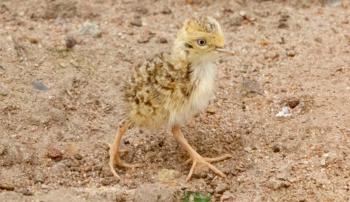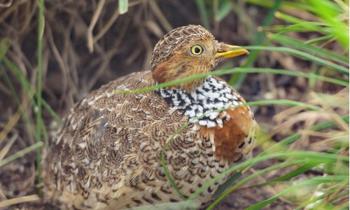Plains-wanderer
In evolutionary terms, the Plains-wanderer is one of a kind. It is the sole member of the family Pedionomidae and there is no bird like it in the world.
Plains-wanderers are beautiful birds. They are mostly brown or buff in colour with white and blackish markings over the body, including spots and streaks on the head and neck. The female has a distinctive black and white speckled collar and rufous-red bib on her chest.
Plains-wanderers prefer short, sparse grasslands that provide cover and space to forage for seeds, leaves and insects.
Once seen from South Australia into Victoria and up to Queensland, the Plains-wanderer has undergone a dramatic decline in the last decade. It is critically endangered and under imminent threat of extinction.

The major threats
The major threat to the survival of the Plains-wanderer is the loss of sparse native grasslands and the condition of the grassland habitat that remains. They like it just right. If the grass cover becomes too thick or too sparse, they abandon the site. Foxes and feral cats also create predation pressure.

The plan for fighting extinction
Zoos Victoria is part of a National Recovery Team, formed in an emergency effort to save the species from extinction.
A purpose-built breeding aviary was opened at Werribee Open Range Zoo in 2017, with Plains-wanderer chicks being born soon after. This conservation breeding program is helping to preserve the species' genetic diversity, provide insurance against extinction, and providing birds to boost wild populations through reintroductions.
How you can help
- Raise community awareness and support for the Plains-wanderers and its grassland habitat.
- Visit our zoos to support our work to fight extinction.
- And donate if you can. As we are a not for profit organisation, all donations go towards our conservation work.
- Discover more about local conservation events and join the growing number of wild activists taking action for local wildlife.
Is your classroom learning about the Plains-wanderer?
Browse through our collection of animal teaching and learning resources for students. These include animal toolkits, e-books, Ask a Zoo Expert resources, video showcases and real-world examples to support the VCE Study Design.
